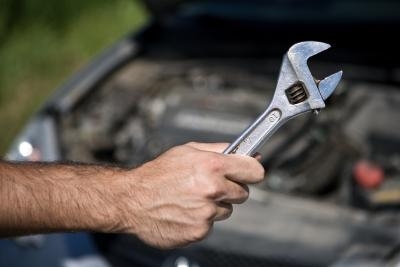
An inlet manifold or intake manifold is an engine part that supplies air and fuel mixture to a vehicle's cylinder. One major problem of a manifold is leaks. An intake manifold leak happens when there is an uneven distribution of air and fuel in a car's engine. For a long time, General Motors had troubles with their 3.4-liter, V6 and 3.1 engines. Before stopping the leak, you must determine the symptoms. Intake manifold gaskets do not always seal properly.
Park your GM car. Raise your vehicle's hood and then position a bright shop light above your car's compartment. Disconnect your vehicle's negative battery cable with a wrench.
Find the throttle bottle and disconnect its air box hose. Pull off the housing of the air cleaner then disconnect the valve host if your GM has a carburetor design.
Remove the vacuum line or sensor wire connected to the intake manifold. If your GM has a carburetor design, then this includes a linkage arm or a throttle cable. Disconnect the linkage arm or throttle cable before removing the manifold. Build a diagram on a paper; showing the proper wires and lines placement to the vacuum valves or sensors. Remove metal lines through a six-sided line wrench.
Use a proper line wrench to disconnect the fuel rail. This is if your GM has one. Disconnect the EGR heat shield by using a screwdriver to remove the screws on the bracket that are holding the shield. Use a flathead screwdriver to unscrew the throttle cable bracket to disconnect it because it hinders the manifold. Use a penetrating oil in spraying the intake manifold bolts. Let the bolts soak in the chemicals for 10 minutes. Spray again to achieve a thorough saturation.
Remove the manifold's mounting bolts. Use proper socket and extension in removing the bolts. The length of bolts might differ so configure them the way you remove them. Utilize a slot screwdriver so you can pry away the manifold from the engine's block surface. Lift out the manifold.
Remove old gasket materials from the manifold. Use a carburetor cleaner and gasket scraper. Wipe the exterior and interior surface of the manifold ports to remove debris. Plug the intake ports to the engine block. Use the carburetor cleaner and the gasket scraper to remove any old gasket materials from the mating surface.
Apply a gasket adhesive coat on the manifold's surface. Press the new gasket on the manifold. If your GM has individual gaskets for every intake port, then press the gaskets individually. The manifold and the block must be aligned before mounting the bolts through hand. Ask for someone's assistance if you need to align the manifold steadily.
Check the manual to determine proper tightening sequence and foot-pound torque pressure. Set the wrench measurement. Tighten all bolts to the proper foot-pounds. Begin from the manifold's core to the fan outward.
Reassemble the cable wire, shield and bracket the way you removed them. The wires and vacuum lines must be clean and tight. Ensure that all components are fit and in proper position. Reconnect the air box intake hose and the negative battery cable. Start your GM's engine and check if there are still leaks.